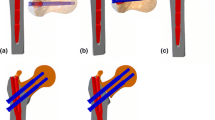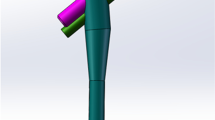Abstract
Introduction
Intramedullary nails for fixation of extracapsular hip fractures have gained popularity recently. Although clinically successful, they are not devoid of complications. An infrequently reported complication is the medial migration of the femoral neck element (FNE) of the implant into the pelvis. The purpose of this study was to create a biomechanical model simulating this effect based on a clinical case radiographic analysis.
Methods
Eight clinical cases of medial migration were available for radiographic analysis. Medial migration was quantified and the fractures were classified. A biomechanical model was built comprising two fixtures containing the nail and FNE respectively. A pivot between the two fixtures, representing a deficient femoral calcar, simulated an unstable fracture type. Two pivot points were used for each nail. The constructs were tested using sinusoidal loading (40–800 N at 2 Hz) and medial migration was assessed. Five different nail designs (TFN, PFN, PFN-a, Gamma-3 and IMHS) were tested (overall 75 tests).
Results
All the five implants demonstrated medial migration to a similar distance. The TFN required the highest number of cycles (3127 ± 2569) and the IMHS the lowest (58.8 ± 3.6) although this difference did not reach statistical significance (P = 0.07). Changing the pivot point for the medial calcar did not alter the results significantly. All eight clinical cases demonstrated an unstable intertrochanteric fracture pattern (AO/OTA 32A2).
Conclusions
Discrete biomechanical conditions are required to reproduce medial migration of the FNE in cephalomedullary devices.





Similar content being viewed by others
References
Adams CI, Robinson CM, Court-Brown CM, McQueen MM (2001) Prospective randomized controlled trial of an intramedullary nail versus dynamic screw and plate for intertrochanteric fractures of the femur. J Orthop Trauma 15(6):394–400
Boldin C, Seibert FJ, Fankhauser F, Peicha G, Grechenig W, Szyszkowitz R (2003) The proximal femoral nail (PFN)—a minimal invasive treatment of unstable proximal femoral fractures: a prospective study of 55 patients with a follow-up of 15 months. Acta Orthop Scand 74(1):53–58
Crawford CH, Malkani AL, Cordray S, Roberts CS, Sligar W (2006) The trochanteric nail versus the sliding hip screw for intertrochanteric hip fractures: a review of 93 cases. J Trauma 60(2):325–328; discussion 328–329
Fogagnolo F, Kfuri M Jr, Paccola CA (2004) Intramedullary fixation of pertrochanteric hip fractures with the short AO-ASIF proximal femoral nail. Arch Orthop Trauma Surg 124(1):31–37
Gardner MJ, Bhandari M, Lawrence BD, Helfet DL, Lorich DG (2005) Treatment of intertrochanteric hip fractures with the AO trochanteric fixation nail. Orthopedics 28(2):117–122
Health TFaDAcfDaR. Medical device reporting. Available at: http://www.fda.gov/cdrh/mdr/index.html
Hesse B, Gachter A (2004) Complications following the treatment of trochanteric fractures with the gamma nail. Arch Orthop Trauma Surg 124(10):692–698
Hohendorff B, Meyer P, Menezes D, Meier L, Elke R (2005) [Treatment results and complications after PFN osteosynthesis]. Unfallchirurg 108(11):938, 940, 941–936 passim
Jones HW, Johnston P, Parker M (2006) Are short femoral nails superior to the sliding hip screw? A meta-analysis of 24 studies involving 3,279 fractures. Int Orthop 30(2):69–78
Lenich A, Mayr E, Ruter A, Mockl C, Fuchtmeier B (2006) First results with the Trochanter Fixation Nail (TFN): a report on 120 cases. Arch Orthop Trauma Surg 126(10):706–712
Mahomed N, Harrington I, Kellam J, Maistrelli G, Hearn T, Vroemen J (1994) Biomechanical analysis of the Gamma nail and sliding hip screw. Clin Orthop Relat Res (304):280–288
Morris AH, Zuckerman JD (2002) National consensus conference on improving the continuum of care for patients with hip fracture. J Bone Joint Surg Am 84-A(4):670–674
Papasimos S, Koutsojannis CM, Panagopoulos A, Megas P, Lambiris E (2005) A randomised comparison of AMBI, TGN and PFN for treatment of unstable trochanteric fractures. Arch Orthop Trauma Surg 125(7):462–468
Parker MJ, Handoll HH (2005) Gamma and other cephalocondylic intramedullary nails versus extramedullary implants for extracapsular hip fractures in adults. Cochrane Database Syst Rev (Online) (4):CD000093
Saudan M, Lubbeke A, Sadowski C, Riand N, Stern R, Hoffmeyer P (2002) Pertrochanteric fractures: is there an advantage to an intramedullary nail?: a randomized, prospective study of 206 patients comparing the dynamic hip screw and proximal femoral nail. J Orthop Trauma 16(6):386–393
Schipper IB, Steyerberg EW, Castelein RM, van der Heijden FH, den Hoed PT, Kerver AJ, van Vugt AB (2004) Treatment of unstable trochanteric fractures. Randomised comparison of the gamma nail and the proximal femoral nail. J Bone Joint Surg 86(1):86–94
Sommers MB, Roth C, Hall H, Kam BC, Ehmke LW, Krieg JC, Madey SM, Bottlang M (2004) A laboratory model to evaluate cutout resistance of implants for pertrochanteric fracture fixation. J Orthop Trauma 18(6):361–368
Tauber M, Resch H (2006) Sigmoid perforation after medial migration of lag screw in gamma nailing. Arch Orthop Trauma Surg 126(2):118–122
Tyllianakis M, Panagopoulos A, Papadopoulos A, Papasimos S, Mousafiris K (2004) Treatment of extracapsular hip fractures with the proximal femoral nail (PFN): long term results in 45 patients. Acta Orthop Belg 70(5):444–454
Utrilla AL, Reig JS, Munoz FM, Tufanisco CB (2005) Trochanteric gamma nail and compression hip screw for trochanteric fractures: a randomized, prospective, comparative study in 210 elderly patients with a new design of the gamma nail. J Orthop Trauma 19(4):229–233
Werner-Tutschku W, Lajtai G, Schmiedhuber G, Lang T, Pirkl C, Orthner E (2002) [Intra- and perioperative complications in the stabilization of per- and subtrochanteric femoral fractures by means of PFN]. Unfallchirurg 105(10):881–885
Acknowledgements
Conflict of interests: Drs Helfet, Gardner and Weil had not received any compensation or support for their participation in the study. Mr Pierson and Mikhail are employees of Synthes Research Facility, West Chester, PA, USA.
Author information
Authors and Affiliations
Corresponding author
Rights and permissions
About this article
Cite this article
Weil, Y.A., Gardner, M.J., Mikhail, G. et al. Medial migration of intramedullary hip fixation devices: a biomechanical analysis. Arch Orthop Trauma Surg 128, 227–234 (2008). https://doi.org/10.1007/s00402-007-0497-2
Received:
Published:
Issue Date:
DOI: https://doi.org/10.1007/s00402-007-0497-2




